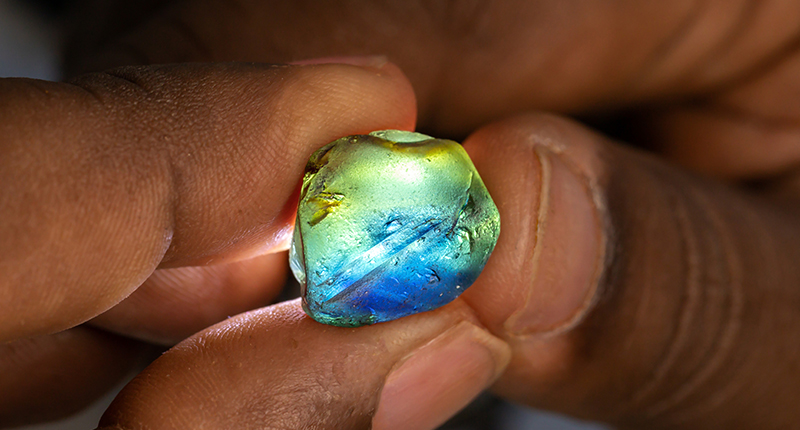The former BHP Billiton leader and Gemfields chairman is remembered for his influential leadership throughout his 50-year mining career.
Survey Says: Sapphire Is King for Both Trade and Consumers
Plus, current consumer interest in colored stones, how sales in the category have been, and more insights from a recent study by MVI Marketing.

In a survey conducted by MVI Marketing of both consumers and the trade, desire for color is high and growing, with sapphire of particular interest to both groups.
Fura Gems sponsored the survey, but survey-takers were told only there was a “colored gemstone mining group who would like to better understand precious gemstones in the U.S. market.”
MVI fielded the survey in fall 2020, receiving responses from 1,011 consumers.
Survey-takers were all based in the United States and mostly female (59 percent vs. 42 percent male).
They also were between the ages of 18-65 and had spent at least $200 on jewelry in the past three years.
MVI also conducted a trade component, interviewing more than 100 U.S. retailers and manufacturers via online surveys and one-on-one interviews.
Here are insights gleaned from the survey and what Fura will do with the findings.
The Consumers: Ready to Buy Colored Stones
According to MVI, 93 percent of consumers said they love or like all colored stones, but there was still a clear favorite—sapphire.
Forty-six percent of all consumers surveyed said they’ve bought sapphires in the past, followed by ruby and emerald (both at 41 percent) and then amethyst (35 percent).
Additionally, 40 percent of consumers specifically between the ages of 23 and 40 chose sapphire as their favorite gemstone, followed closely by ruby and emerald, with half of the group having purchased sapphire jewelry before.
When asked their preferred shade of blue sapphire, 46 percent chose the darkest shade they were shown, followed by the medium blue at 40 percent and light blue at 14 percent.
Consumers also expressed interest in sapphires of other colors.
When shown parti sapphires (multi-colored), 78 percent of survey takers said they love or like them, though not many in the trade carry them (18 percent of retailers and 15 percent of suppliers).
Consumers also expressed interest in black sapphires—with 70 percent of consumers saying they love or like them—and the fancy sapphires they were shown (a range of yellows, greens, and bluish greens)—with 68 percent of buyers saying the same thing.
MVI also asked about preferences for ruby color, and there was a clear disconnect between what consumers wanted and what the trade prefers.
When presented with a dark, medium and light-colored rubies, nearly half of consumers (46
Of trade members, 69 percent of manufacturers and 88 percent of retailers indicated they preferred the medium-colored material, with far fewer choosing the darkest-colored ruby (31 percent and 12 percent, respectively) and none picking the light.
Manufacturers noted in their feedback that the dark material was harder to find and more expensive to source.
When asked about metal preferences, consumers picked white gold as the top choice for both sapphires and rubies, followed closely by yellow gold and platinum.
They chose oval shapes over rounds for both as well.
When it comes to bridal, 38 percent said it was “highly likely” either they or their partner would choose a sapphire for an engagement ring or wedding band.
This doesn’t come as a surprise, since sapphire has been making headway into bridal jewelry for a while now, as both accent and center stones.
RELATED CONTENT: Experts Weigh in on the Hottest Bridal Trends of 2021
MVI referred to current data that shows retailers have increased their colored gemstone jewelry options for bridal to 15 percent.
Meanwhile, when asked about certain social concerns, 42 percent of consumers said the origin of colored stones was “very important” and 37 percent said it was “somewhat important.”
Forty-nine percent also said it was very important to them to know how the workers at a mine or cutting factory are treated, while 33 percent said it was somewhat important.

When the survey dove into the top colored stone for the trade, sapphires came in first there too.
According to MVI, sapphire is “by far” the No. 1 revenue generator for both retailers and manufacturers, topping emerald and ruby, with blue sapphire, unsurprisingly, the most common color sold.
Trade members who participated in the study also were asked about their sales from 2018-2019 and what they anticipate for the future.
Eighty-six percent of manufacturers and 54 percent of retailers said sapphire sales were up in that period, with 14 percent and 46 percent, respectively, saying they were about the same.
Eighty-five percent of manufacturers said ruby sales rose or stayed the same during that period; the same was true for 92 percent of retailers.
Emerald sales increased or maintained for 86 percent of manufacturers and 83 percent of retailers.
And, for 92 percent of manufacturers and 75 percent of retailers, the margins are better for colored stones than diamonds: colored gems generally bring in margins of 40 percent for manufacturers and 65 percent for retailers, survey-takers reported.
For a third of manufacturers and designers, the per-carat sweet spot is under $100 for wholesale, and for more than half of retailers, most of which were independents, the per-carat sweet spot is between $800 and $2,000 for consumers.
MVI also asked the trade members if country of origin was important to them, as consumers indicated it was. Most said they are more concerned with the value of a stone than the country from which it came.
What’s Next for Fura
Interestingly, MVI also dug into barriers to selling color for the trade members they interviewed and surveyed.
Among retailers who participated, about half (47 percent) said there were no barriers—they are “doing fine” with selling color.
Meanwhile, about a third said customers don’t ask for colored gemstones while 25 percent said they don’t advertise or promote them.
Another 16 percent said their salespeople “don’t like to or don’t know how to” sell color and the remaining 6 percent said price points were too high.
When it came to manufacturers, the highest percentage—45 percent—said retailers don’t know how to sell color, while 27 percent said they (the manufacturer) don’t advertise or promote them enough, and another 27 percent said it’s that they don’t offer co-op support to clients.
The final 18 percent was split evenly—9 percent said price points were too high and 9 percent said customers (meaning retailers) don’t ask for them.
Ultimately, these findings indicate both trade groups are “ripe for leadership and promotion of the color category,” MVI said in its results.
It also found, as has been explained above, that there is plenty of consumer interest in colored stones.
Fura said in a recent interview with National Jeweler that it plans to use the feedback received in the survey as the backbone for a new marketing push in the U.S. that will be a focus in 2021.
They are teaming up with MVI to create a marketing strategy, as well as an education and training plan, to help both business-to-business clients as well as the business-to-consumer clients, to not only get the word out about colored stones but also so all parts of the supply chain feel comfortable selling them.
Fura is currently the only colored stone miner with a stake in all the “Big 3,” having completed the acquisition of an Australian sapphire mining project in January 2020.
The Latest

The LVMH-owned brand has partnered with the costume design union to revamp its award for 2026.

The luxury titan inked a deal to acquire an initial minority stake in the jewelry manufacturer with a pathway to full ownership by 2032.

How Jewelers of America’s 20 Under 40 are leading to ensure a brighter future for the jewelry industry.

The company’s curation of unsigned vintage and estate jewelry debuted at the Bloomingdale’s in Costa Mesa, California.


In the recent multi-shipment seizure, CBP also found counterfeit Audemars Piguet, Moncler, and Chrome Hearts items.

Helzberg’s Chief Retail Officer Mitch Maggart shared details about its tests of a new store concept rooted in an elevated luxury experience.

Roseco’s 704-page catalog showcases new lab-grown diamonds, findings, tools & more—available in print or interactive digital editions.

Jewelers of America execs and National Jeweler editors discuss tariffs, the sky-high gold price, and the engagement that broke the internet.

The luxury goods company said founder Ippolita Rostagno will remain at the brand’s helm.

Laura Burdese, who joined the Italian luxury brand in 2022, will take on the role in July.

The National Jeweler editors revisit the most noteworthy industry happenings and design trends from 2025.

Need a gift for the cat lover who has everything? Look no further than our latest Piece of the Week.

It purchased the “Grosse Pièce,” an ultra-complicated Audemars Piguet pocket watch from the ‘20s, for a record-breaking price at Sotheby’s.

The lab-grown diamond grower now offers custom engagement and fashion jewelry through its Kira Custom Lab Jewelry service.

Chandler got his start at Michelson Jewelers and has served as DCA president and CEO since 2001. He will retire at the end of the month.

The boutique is slated to open this week inside Terminal 8, offering pre-owned Rolex watches and more to international travelers.

Sponsored by Digital Monitoring Products

The special-edition egg pendant ingested in a New Zealand jewelry store was recovered after a six-day wait.

Associate Editor Natalie Francisco plays favorites with Piece of the Week, selecting a standout piece of jewelry from each month of 2025.

The “Love and Desire” campaign is inspired by the magic that follows when one’s heart leads the way, said the brand.

Two awardees will receive free tuition for an educational course at the Swiss lab, with flights and lodging included.

Berta de Pablos-Barbier will replace Alexander Lacik at the start of January, two months earlier than expected.

Sotheby’s held its first two jewelry sales at the Breuer building last week, and they totaled nearly $44 million.

Winners will receive free registration and lodging for its fourth annual event in Detroit.

Here are six ideas for making more engaging content for Instagram Reels and TikTok, courtesy of Duvall O’Steen and Jen Cullen Williams.

The honorees include a notable jewelry brand, an industry veteran, and an independent retailer.



























